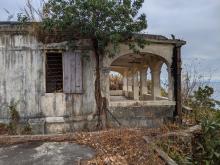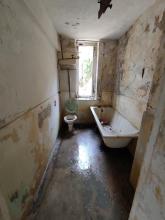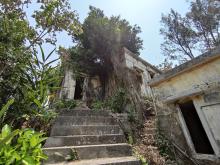Current condition
Ruin
House #11 is marked on the 1938 map: https://gwulo.com/node/46976?a=1#18/22.20391/114.03827/Map_by_ESRI-1938…
There's a house there on the modern ESRI layer too, but it's not clear if it's the original or a modern re-build: https://gwulo.com/node/46976?a=2#18/22.20391/114.03827/Map_by_ESRI-1938…
It may be the building shown at top right in this photo:




Comments
Photos of #11 House
The finishes and tiles of this house is in pre-war style.
It might be used as a holiday camp some time ago.
("Latin: Maria Auxilium Christianorum, ora pro nobis" from google, Selesian of Don Bosco website)
House #11 Overview
This house differs from all the others in that it is a larger bungalow with a small one built beside it.
Sturdily built of granite on the south-east side of Fa Peng, it is south-facing and has a five-arched verandah along its front with solid pillars. The roof is flat reinforced concrete.
Another unusual feature is the metal shutters on metal window frames and metal door.
Down some steps on a lower level is the small bungalow, with possibly just two rooms, which has its own south-facing mini verandah.
In the 1938 list of European owners of houses on Cheung Chau, the owner of House #11 is given as Mr Rev L J Lowe (sic), who may have been a missionary, but it's not known if this was a holiday or permanent residence.
When the Japanese invaded in 1941 the occupants were an American family named Gates, who were expecting their third child. Milton Halsted Gates was a Presbyterian missionary, who was there with his wife Sylvia and their two children, William and Sylvia. Baby Daniel was born on the 15th December in the Matilda Hospital, which was free for missionaries.
In 1942, the family was initially housed in the New Asia Hotel before being interned in Stanley Camp and later that year repatriated on the Gripsholm to the United States.
See http://www.hongkongwardiary.com/searchgarrison/nonuniformedcivilians.html